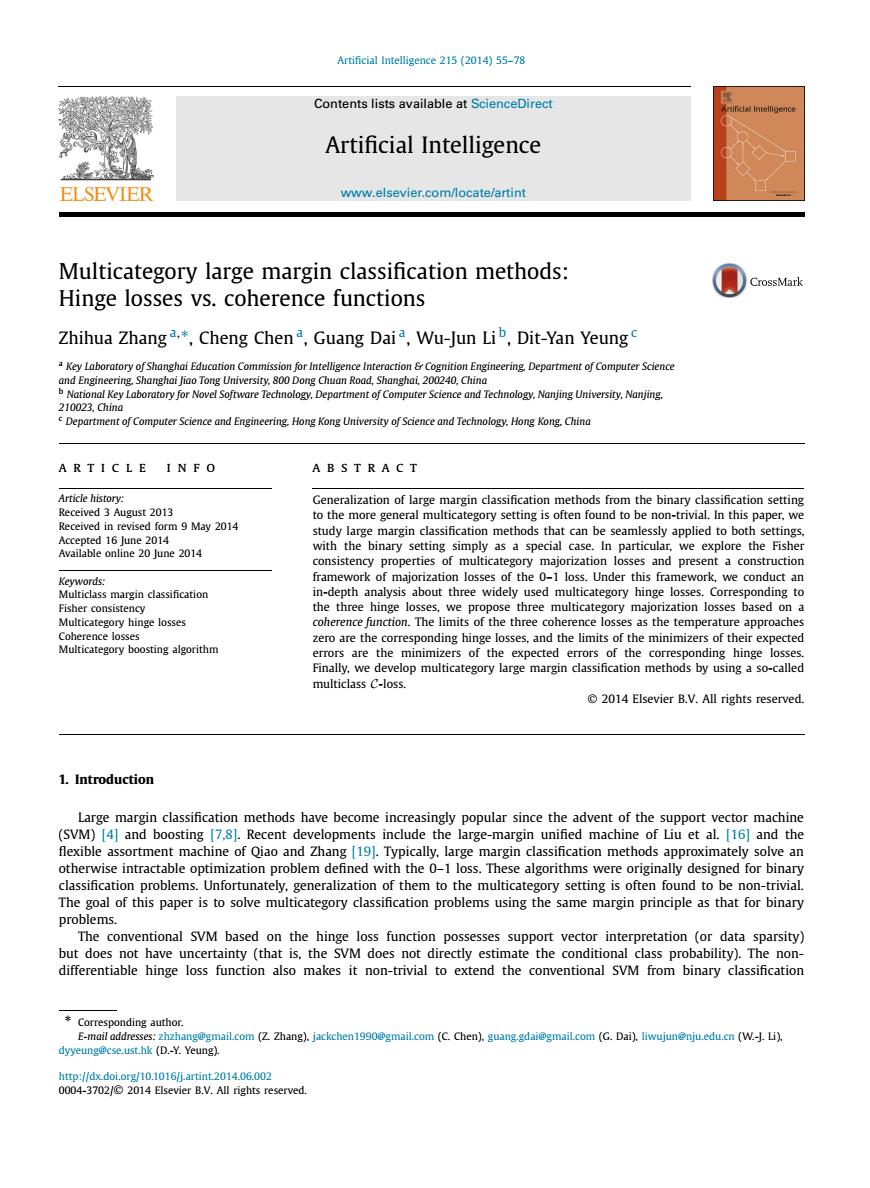正在加载图片...

Artificial Intelligence 215 (2014)55-78 Contents lists available at ScienceDirect rtificial Intelligence Artificial Intelligence ELSEVIER www.elsevier.com/locate/artint Multicategory large margin classification methods: CrossMark Hinge losses vs.coherence functions Zhihua Zhang3.*,Cheng Chen,Guang Daia,Wu-Jun Lib,Dit-Yan Yeung a Key Laboratory of Shanghai Education Commission for Intelligence Interaction Cognition Engineering.Department of Computer Science and Engineering.Shanghai Jiao Tong University,800 Dong Chuan Road,Shanghai,200240.China b National Key Laboratory for Novel Software Technology,Department of Computer Science and Technology.Nanjing University.Nanjing. 210023.China Department of Computer Science and Engineering.Hong Kong University of Science and Technology.Hong Kong.China ARTICLE INFO ABSTRACT Article history: Generalization of large margin classification methods from the binary classification setting Received 3 August 2013 to the more general multicategory setting is often found to be non-trivial.In this paper,we Received in revised form 9 May 2014 study large margin classification methods that can be seamlessly applied to both settings, Accepted 16 June 2014 Available online 20 June 2014 with the binary setting simply as a special case.In particular.we explore the Fisher consistency properties of multicategory majorization losses and present a construction Keywords: framework of majorization losses of the 0-1 loss.Under this framework,we conduct an Multiclass margin classification in-depth analysis about three widely used multicategory hinge losses.Corresponding to Fisher consistency the three hinge losses,we propose three multicategory majorization losses based on a Multicategory hinge losses coherence function.The limits of the three coherence losses as the temperature approaches Coherence losses zero are the corresponding hinge losses,and the limits of the minimizers of their expected Multicategory boosting algorithm errors are the minimizers of the expected errors of the corresponding hinge losses. Finally,we develop multicategory large margin classification methods by using a so-called multiclass C-loss. 2014 Elsevier B.V.All rights reserved. 1.Introduction Large margin classification methods have become increasingly popular since the advent of the support vector machine (SVM)[4]and boosting [7,8].Recent developments include the large-margin unified machine of Liu et al.[16]and the flexible assortment machine of Qiao and Zhang [19.Typically,large margin classification methods approximately solve an otherwise intractable optimization problem defined with the 0-1 loss.These algorithms were originally designed for binary classification problems.Unfortunately,generalization of them to the multicategory setting is often found to be non-trivial. The goal of this paper is to solve multicategory classification problems using the same margin principle as that for binary problems. The conventional SVM based on the hinge loss function possesses support vector interpretation (or data sparsity) but does not have uncertainty (that is,the SVM does not directly estimate the conditional class probability).The non- differentiable hinge loss function also makes it non-trivial to extend the conventional SVM from binary classification *Corresponding author. E-mail addresses:zhzhang@gmail.com (Z Zhang).jackchen1990@gmail.com (C.Chen).guang.gdai@gmail.com (G.Dai).liwujun@nju.edu.cn (W.-J.Li). dyyeung@cse.ust.hk (D.-Y.Yeung) http://dx.doi.org/10.1016/j.artint.2014.06.002 0004-3702/2014 Elsevier B.V.All rights reserved.Artificial Intelligence 215 (2014) 55–78 Contents lists available at ScienceDirect Artificial Intelligence www.elsevier.com/locate/artint Multicategory large margin classification methods: Hinge losses vs. coherence functions Zhihua Zhang a,∗, Cheng Chen a, Guang Dai a, Wu-Jun Li b, Dit-Yan Yeung c a Key Laboratory of Shanghai Education Commission for Intelligence Interaction & Cognition Engineering, Department of Computer Science and Engineering, Shanghai Jiao Tong University, 800 Dong Chuan Road, Shanghai, 200240, China b National Key Laboratory for Novel Software Technology, Department of Computer Science and Technology, Nanjing University, Nanjing, 210023, China c Department of Computer Science and Engineering, Hong Kong University of Science and Technology, Hong Kong, China a r t i c l e i n f o a b s t r a c t Article history: Received 3 August 2013 Received in revised form 9 May 2014 Accepted 16 June 2014 Available online 20 June 2014 Keywords: Multiclass margin classification Fisher consistency Multicategory hinge losses Coherence losses Multicategory boosting algorithm Generalization of large margin classification methods from the binary classification setting to the more general multicategory setting is often found to be non-trivial. In this paper, we study large margin classification methods that can be seamlessly applied to both settings, with the binary setting simply as a special case. In particular, we explore the Fisher consistency properties of multicategory majorization losses and present a construction framework of majorization losses of the 0–1 loss. Under this framework, we conduct an in-depth analysis about three widely used multicategory hinge losses. Corresponding to the three hinge losses, we propose three multicategory majorization losses based on a coherence function. The limits of the three coherence losses as the temperature approaches zero are the corresponding hinge losses, and the limits of the minimizers of their expected errors are the minimizers of the expected errors of the corresponding hinge losses. Finally, we develop multicategory large margin classification methods by using a so-called multiclass C-loss. © 2014 Elsevier B.V. All rights reserved. 1. Introduction Large margin classification methods have become increasingly popular since the advent of the support vector machine (SVM) [4] and boosting [7,8]. Recent developments include the large-margin unified machine of Liu et al. [16] and the flexible assortment machine of Qiao and Zhang [19]. Typically, large margin classification methods approximately solve an otherwise intractable optimization problem defined with the 0–1 loss. These algorithms were originally designed for binary classification problems. Unfortunately, generalization of them to the multicategory setting is often found to be non-trivial. The goal of this paper is to solve multicategory classification problems using the same margin principle as that for binary problems. The conventional SVM based on the hinge loss function possesses support vector interpretation (or data sparsity) but does not have uncertainty (that is, the SVM does not directly estimate the conditional class probability). The nondifferentiable hinge loss function also makes it non-trivial to extend the conventional SVM from binary classification * Corresponding author. E-mail addresses: zhzhang@gmail.com (Z. Zhang), jackchen1990@gmail.com (C. Chen), guang.gdai@gmail.com (G. Dai), liwujun@nju.edu.cn (W.-J. Li), dyyeung@cse.ust.hk (D.-Y. Yeung). http://dx.doi.org/10.1016/j.artint.2014.06.002 0004-3702/© 2014 Elsevier B.V. All rights reserved